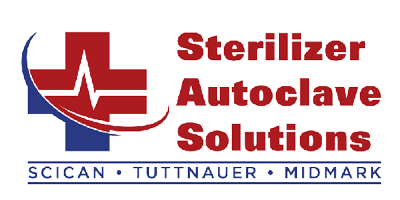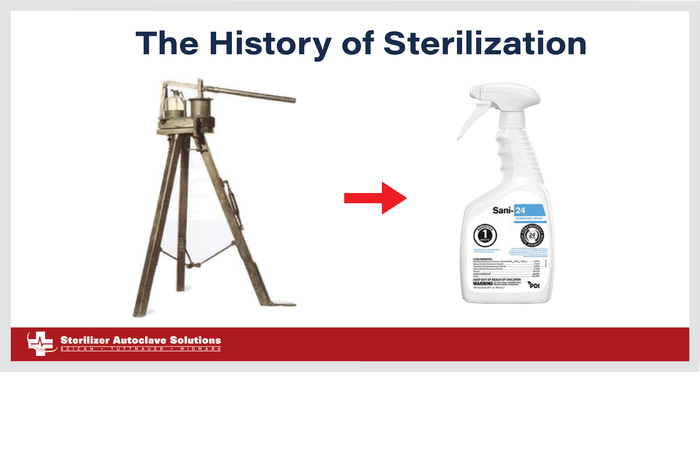The History of Sterilization
Recently we had discussed the history of the autoclave. Our bread and butter. What brought the idea of steam sterilization to the point where it’s at today. And to think that the history of the autoclave started with a pressure cooker. If you’d like to read more about that, you can do that here. But the first autoclave wasn’t brought about till around the late 1800’s. However, the concept of sterilization goes back much, much farther. Bringing us back all the way to the advent of the Egyptians. Their methods of preservation were where all of this was said to have taken shape. Very different from what we know today, but the journey of a thousand miles begins with a single step. And that step just happened to be headed in the right direction. So in this article we’d like to share with you what we learned on our deep dive into the history of sterilization.
Where It All Started
The idea of infections and disease were actually thought to be the product of demons at one point. There’s no real way to dance around it, but that’s just how it was. Humans feared the unknown, that’s a given. But what’s more unknown than an unseen scourge of disease that in that time, you’d never have the materials to cure. Plagues were thought to be the work of evil spirits and demons. And witchcraft and magic methods were used to attempt to drive it away. Suffice it to say, witchcraft is not what we would consider today to be FDA approved infection control. But the actual first cases of anything along the lines of infection control was antiseptic methods by the Egyptians.
The Egyptians (3,000 B.C.)
The Egyptians used pitch, tar, resin and aromatics to embalm bodies before they even had a written language. Niter and common salt were also used for their antiseptic value because they caused a drying effect. In fact, the reason you can still see intact mummies today is because of how skillful they were at the embalming process. While this may not seem important to sterilization, the origin is quite clear. The concept of preservation was the start of the idea that prevention of infection was possible. They found out that copper was an effective infection prevention method. They used it to sterilize wounds and water.
The Greeks (550 B.C.-200 A.D.)
So, you may or may not have expected this from the Greeks, can’t say I did. But they came up with quite the interesting method of infection control in battle. About 550 B.C. was when this was recorded to have first happened. But Greek soldiers called hoplite would sometimes just fight naked sometimes. They didn’t 100% know why themselves, but they knew the general concept of infection. And they did this because they realized that clothing pierced by a sword or spear could find its way into the wound. And that fabric could in turn lead to a nasty infection. So their solution? If clothes are the cause, the effect is just don’t wear them.
Hippocrates of Cos was another notable name amongst the Greeks in the wake of sterilization ideas. He separated the idea that disease was linked to some form of philosophical punishment for sin. And after separating the science and the philosophy, he advocated the use of wine or boiled water to stave off infection. He also tried to keep the plague at bay by lighting aromatic wood on fire. And even Aristotle told Alexander the Great to tell his soldiers to boil their drinking water before ingesting it.
And a Greek practitioner named Galen is another example of why they say that these past methods of infection control were ahead of their time. Galen was Greek but worked in Rome treating Roman soldiers. And he made a point to boil his instruments before using them on anybody. His writings along with those of Hippocrates made them some of the bigger names in medical authority for centuries.
The Plague (900-1500 A.D.)
What makes the developments in infection control that we’d been mentioning so fascinating is that no one knew that the heat was as effective as it actually was. Think about that for a second. Centuries worth of different methods of infection control spanning through the ideas of different cultures. And none of them really knew WHY. They just knew that what they were doing was effective but they didn’t understand fully how the heat actually helped.
But once the Plague came, progress was practically non-existent. The Plague’s hold on everyone put the evolution of new ideas of sterilization at a standstill. Nothing was coming through for them in all of the chaos the Plague brought. There were attempts to try and keep it out and combat it in hospitals and infected housing. Things like:
- Cleaning solution
- Aeration
- Smoke of straw burning
- Vinegar fumes
- Fumes of sulfur, antimony, and arsenic
But from that period, nothing noteworthy came about. The Plague was ravaging Europe and tearing through the Middle Ages. But the second half of the 17th century proved more fruitful for sterilization. Because around that time, a certain invention was in the process of being invented. A practical device using a concave lens at an adjustable level to allow us to see microorganisms. What we know today as the first practical microscope.
The 17th Century Turnaround
The 17th Century was a big time for the evolution of sterilization. Finally there were major steps being taken by a few select individuals that can help get us to the present. And we’ve discussed two of them before in our history of the autoclave, but they aren’t the only ones that matter this time. There are many other things that contribute to sterilization as a whole. But it starts in 1680 with the pressure cooker.
Denis Papin and the “Digester” (1680)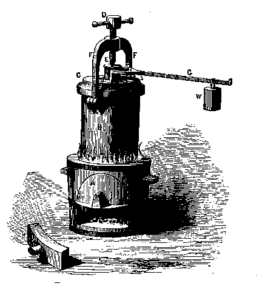
The first ever iteration of any concept of superheated pressure chambers was in the form of the pressure cooker. French physicist Denis Papin brought that to us. He invented a chambered pressure cooking device that can create a tight seal between the pot and lid. Known only as the “Digester,” this device trapped hot air in the chamber and it causes it to expand. But because the air is trapped, as it would expand, pressure would form. And this pressure also increased the boiling point of the water inside. And this superheated steam would penetrate whatever food item would be put in it, effectively cooking it.
This was the first instance of steam penetration by way of a superheated pressurized chamber. But it wouldn’t be until a bit later on that the idea of using this method for steam sterilization came about. So we have the pressurized steam chamber. Now we’ll move on to how they detected the microorganisms in the first place.
Antoni van Leeuwenhoek and the Microscope (1683)
We mentioned Antoni’s accomplishment in our history of the autoclave a little bit, but now we have a bigger reason. After all, what good is sterilization if you don’t know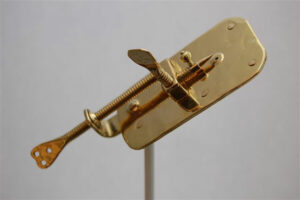 what you’re looking for? Antoni van Leeuwenhoek was a dutch linen draper and one day he was trying to get a better look at a linen thread. But what he had on hand wasn’t cutting it. The standard magnifying lenses he had didn’t get down to the fine points he needed. This caused him to take an interest in the idea of more magnifying lenses. So he experimented with optics and microscopes and managed to make the first ever microscope. Which by the way, was better than any of the ones available at the time.
what you’re looking for? Antoni van Leeuwenhoek was a dutch linen draper and one day he was trying to get a better look at a linen thread. But what he had on hand wasn’t cutting it. The standard magnifying lenses he had didn’t get down to the fine points he needed. This caused him to take an interest in the idea of more magnifying lenses. So he experimented with optics and microscopes and managed to make the first ever microscope. Which by the way, was better than any of the ones available at the time.
With his microscope having a magnification of up to 270x, Leeuwenhoek was able to prove the existence of microorganisms. And that, in turn, gave him the nickname the “father of microscopy.” His invention would help usher in a new wave of infection control. Because now with the existence of the microorganism that the microscope can reveal, there was a reason for infection control to exist.
The First Surgical Glove (1758)
We all know how important personal protection equipment is. But back then there wasn’t a whole lot of options. But then one doctor had an idea for a glove. And while the material is a bit more exotic than nitrile, worked out well for what he needed. Dr. Johann Julius Walbaum had ended up fashioning himself some surgical gloves to deliver babies… out of sheep intestines. A bit of a strange choice, and there’s no reason why he used sheep intestines specifically. But it paved the way for the use of personal protection equipment from then on.
Preservation of Food by Canning (1795)
Back around this time of the century, soldiers were having a hard time preserving their foods. And this in turn most likely meant less food if they couldn’t eat it in time or store it properly for when they could. So Napoleon held a cash prize brainstorming contest for anyone who can help prevent the soldiers’ food from going off. And that 12,000 francs grand prize would go to none other than chef Nicholas Appert. See, he realized that if you can store food in an airtight container, it can presumably gain a longer shelf life.
Enter the canning process. Appert found that by sealing jars with pitch and then boiling them, that you can preserve meat and veggies just fine. And just like that, he got a cash prize and the world of sterilization just got bigger and better.
The Modern Era
The modern era evolution of sterilization takes place in the mid 1800’s and beyond to the present day. The age of the first autoclave all the way up to the big names we know and love today. And other important items and ideas that all contribute to the greater evolution in sterilization.
Pasteurization (1862)
When you think of the word pasteurization, first thing you might think of is the kind of milk you choose to buy. A lot of people may see the word and assume it means that it has an advantage of some kind. But they might not understand how important the pasteurization process actually is. It’s a process in which food and dairy products are heated to a high temperature to kill any pathogens that may be floating around in it. And its name was taken from Louis Pasteur. A French chemist and microbiologist who published his findings on how germs cause disease. And these findings later helped him developed the pasteurization process as we know it to this day.
First Use of Antiseptic Spray (1867)
Around this time was when a man named Joseph Lister had reduced the mortality rate in his patients using antiseptic spray. The first recorded instance of antiseptic spray too. It was a carbolic solution spray that he used while he operated. Then he used it on the wound itself, followed by any articles of clothing that came in contact with it. Finally on the hands of his operating team.
The Autoclaves and Steam Sterilization
Now we’re at the point where we should all feel right at home. We’ve reached the time of the first autoclave and the revolutionary mark it had on the future of sterilization. But there are other notable events from that same time-frame. Heat-resistant bacteria was discovered just 3 years prior, and it came at the hands of one John Tyndall. And his discovery led to him originating the idea of fractional sterilization by intermittent heating. But around 3-5 years later, the advent of autoclave was here. And a few great minds went into the creation of the first autoclave to make sure that it was as effective as it should be.
The Autoclave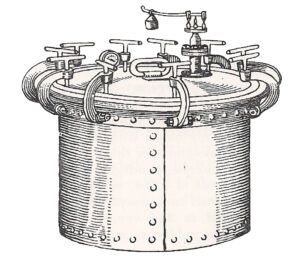
Charles Chamberland created the first actual medical autoclave device. This machine being a predecessor to Denis Papin’s “Digester.” But it was the input from other great minds that came together to fine tune the properties of this iconic sterilization tool. For example, Pasteur himself noted that moist heat works better than a dry heat. Therefor, the “steam” in steam sterilizer was introduced into the mix. Robert Koch is another name to be mentioned in the autoclave’s engineering. Koch was a German bacteriologist, and he and his colleagues mentioned that there were certain limitation to steam at 100 degrees. An American scientist, J.J Kinyoun, said that a vacuum process would be beneficial to increase penetration of objects inside the autoclave.
And all of this input from many different minds helped to create the advancement of the autoclave. And now we get closer to where we are today with sterilization.
Notable Exceptions
There were other events in sterilization that had happened up to the next point, but none of them were extensively talked about. So we formatted it into a digestable bullet list of rapid-fire sterilization facts from the late 1800’s to the 1930’s.
- 1881 – Sterilization by boiling became common practice. Linens, dressings, and gowns, and anything else used during operation was boiled.
- 1885 – German physician Ernst von Bergmann used the steam sterilizer on surgical attire.
- 1886 – Gustav Neuber brought mercury chloride into play to clean his apron, and advocated sterilization of furniture and anything that came in contact with a wound.
- 1889 – Dr. William Stewert Halstead asked Goodyear Rubber Co. to make him a rubber glove with gauntlets as protection. It was a hit, and soon more gloves were requested by other operating rooms.
- Late 1800’s – Surgical instruments got a new design overhaul that required them to be smooth, and able to be taken apart and more carefully and thoroughly clean.
- Early 1900’s – Ozone becomes Europe’s key potable water treatment option
- 1929 – Ethyline oxide is recognized as an antibacterial agent to sterilize imported spices and furs. But originally used as a fumigant for insects.
The 1930’s to the Present
The 1930’s were a time in which the design of the autoclave was on a constant fine-tuning process. The approach to steam sterilization became more scientific with the way the advancements were going. 1933 was specifically when American engineers began making the kinds of changes mentioned. And with these advancements, the steam sterilizer was being perfected. Each iteration from each new company willing to try their hand at it being different than the last. Using the newest in design features like the development of temperature control systems, monitoring chamber temperature and pressure. But it wasn’t just steam sterilization anymore. At a certain point, there were discoveries of multiple different kinds of sterilization options. Such as ethylene oxide becoming a sterilization agent, which in turn, paved the way for sterilization by radiation.
The Spalding Classification
Around 1968, there was an American physician who came up with an idea that is still in practice today. His name was Earle Spalding, and he made a way to categorize material to sterilize by contact with the patient. Meaning, depending on how the tool was used, it’ll fit into a category with other tools that were used in a similar manner to be sterilized a certain way. The classification system is built like this:
- Critical – objects which enter normally sterile tissue or the vascular system or through which blood flows should be sterile.
- Semi-critical – objects that touch mucous membranes or skin that is not intact require a disinfection process (high-level disinfection[HLD]) that kills all microorganisms but high numbers of bacterial spores.
- Non-critical -objects that touch only intact skin require low-level disinfection.
Steris, Statim and Beyond
In 1985, a company called Steris was founded and had been making significant advancements for sterilization. They offered (and still offer) many forms of sterilization methods like Steam, Ethylene oxide, Gamma, X-Ray, E-Beam and low temperature sterilization using hydrogen peroxide. They were quite a name, and even contributed now by keeping record of the dates of important times in sterilization history. But it wasn’t without its downsides. In 1989, the Steris 1 was introduced. A low temperature peracetic acid system for endoscopic devices. But was rejected by the FDA in 2008 and had to be removed from the marketplace.
Conversely, in 1989, a name you’ll be familiar with, Statim showed its face. Statim had something new to offer too, from Ontario, Canada. Their Statim high speed steam autoclave was introduced into the U.S. And with our previous blog which you can find here, you’ll know ll about what happened from here. Sterilization as a whole had now been forever changed when high-speed autoclaves had dominated the market and still do. All different kinds of sterilizers exist today. There’s pre/post vacuum, classic steam, gravity, ultrasonic cleaners, and all in varying shapes and sizes. It’s safe to say that now there’s a little something for everyone.
Final Thoughts
While the autoclaves and companies they come from had their own bit of history, it’s safe to say the history of sterilization is vastly larger. This being due in part to the fact that autoclaves are a specific piece of the puzzle to the whole that is sterilization. Sterilization has been around for thousands of years. passed through different cultures and ever evolving to adapt to the technology that was available at every different point in time. And it’s always such a fascinating thing to learn. How things looked before they were updated to how we see them today. Like the surgical glove or even the microscope.
And with how fast technology is advancing now, who knows. Maybe we’re living in an evolutionary period for sterilization that’ll be ready for the next batch of history books.
As always if you have any questions about this process or anything else please feel free to contact us and take advantage of our “FREE TECH SUPPORT.”
We also offer FREE VIRTUAL TECH SUPPORT to “See and Talk” with a “Real Time Live Technician” for any problems you may be in need of help with.
You can also use our “FREE MAINTENANCE PROGRAM”. Take the guesswork and worrying about what unit is due for maintenance and which maintenance cycle it is time for. We will keep track of all your autoclaves and let you know when it’s time for anything.
